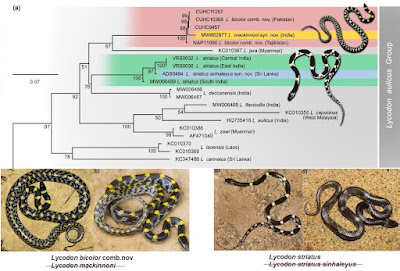 |
| Barred Wolf Snakes in the Lycodon striatus Complex in Amarasinghe, Masroor, Lalremsanga, Weerakkody, ... et Jablonski, 2023. DOI: 10.1111/zsc.12587 |
Abstract
We reviewed the systematics of Lycodon striatus (Shaw, 1802), including all available name-bearing types of its synonyms after evaluating phylogeographic (genetics), morphological (morphometry, meristic, and hemipenes), osteological and distribution evidence. Lycodon striatus sensu lato is widely distributed throughout South and Central Asia and mimics elapids. Based on phylogenetic analyses of mitochondrial DNA, we demonstrate that populations from (i) eastern and central Peninsular India plus Sri Lanka and (ii) south-western parts of Central Asia form two different clades representing two distinct species: L. striatus sensu stricto and L. bicolor comb. nov. respectively. These two clades are sisters to L. deccanensis (in the case of L. striatus) and L. jara (in the case of L. bicolor) and together form two main sister radiations. Although the external morphological variability is high in both species, the genetic variability is higher only in L. striatus but not distinct enough to represent more than one species if using the phylogenetic or biological species concept. The phylogeny of the L. aulicus group hints at Sri Lankan L. striatus, likely having evolved in continental Asia through a probable overland dispersal across the Bay of Bengal (present Palk Strait) into Sri Lanka. This dispersal may have been facilitated by low sea levels during the Pleistocene glaciations when Sri Lanka was connected to mainland India. After considering genetic divergence (with a p-distance of 1.8%–2.1% in the mitochondrial cytochrome b gene) and morphological evidence, we synonymize the Sri Lankan subspecies, L. s. sinhaleyus Deraniyagala, 1955, with L. striatus sensu stricto. The eastern and central Indian L. striatus (i.e. L. striatus sensu stricto) is morphologically distinct and deeply divergent genetically compared to Tajik and Pakistani L. bicolor with a p-distance of 13.6% in cytochrome b gene (mtDNA). Interestingly, L. bicolor is conspecific (p-distance 1.4%) with L. mackinnoni, a western Himalayan endemic, and it reveals intraspecific clinal variation.
Keywords: Asia, iconotype, Lycodon mackinnoni, Lycodon striatus sinhaleyus, neotype, nomen dubium, subspecies
Amarasinghe A. Thasun Amarasinghe, Rafaqat Masroor, Hmar T. Lalremsanga, Sanjaya Weerakkody, Natalia B. Ananjeva, Patrick D. Campbell, Stevie R. Kennedy-Gold, Sanjaya K. Bandara, Andrey M. Bragin, Atthanagoda K. A. Gayan, Vivek R. Sharma, Amit Sayyed, Lal Biakzuala, Andradige S. Kanishka, Sumaithangi R. Ganesh, Ivan Ineich, Anslem de Silva, Lakshman J. M. Wickramasinghe, Sampath S. Seneviratne, Nikolay A. Poyarkov, Gernot Vogel and Daniel Jablonski. 2023. Integrative Approach resolves the Systematics of Barred Wolf Snakes in the Lycodon striatus Complex (Reptilia, Colubridae). Zoologica Scripta. DOI: 10.1111/zsc.12587

